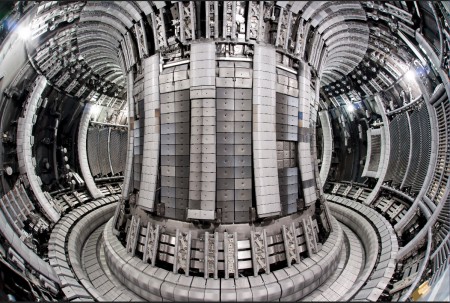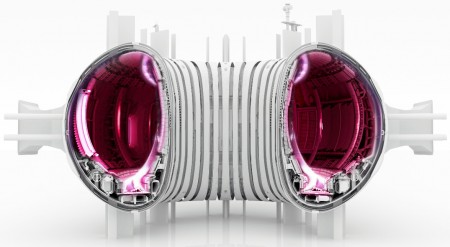Oct
9
The Most Expensive Irrational Optimism for Fusion Power
October 9, 2012 | 5 Comments
The conference aims to discuss various options with the goal of building the first demonstration power plant before the middle of the 21st century, 38 years out in the future.
Before simply thinking things though is interjected, operation with a new lining inside JET has demonstrated the suitability of materials for the much larger and more powerful ITER device.
The JET is Europe’s premier magnetic confinement fusion facility, based at Culham, UK, JET has completed eleven months of tests to simulate the environment inside the ITER and to prototype key components. For the tests JET was transformed successfully into a ‘mini-ITER’ with an inner confinement wall made of the same materials – beryllium and tungsten – that ITER plans to use.
The JET is another tokamak fusion reactor, that’s a ring-shaped vacuum vessel in which very hot plasma is confined using magnetic fields just outside the vessel – something the Soviets thought up and ‘gifted’ to the West during the Cold War. The concept has proven not to be improbable, only improbably expensive.
The tokamak confinement runs very hot at high pressure so choosing correct materials for the inner wall of this vessel is essential. The first problem is the heat and pressure erode the confinement walls thus engineering out the ‘pollution’ when small amounts of wall materials enter the plasma, and the second problem is to prevent the fusion fuels from saturating and becoming trapped in the wall. Considering the temperatures, pressures and the speeds, plus the idea that there will be fusion going on, sets a very high standard.
The Jet work demonstrated the suitability of materials beryllium for the main wall and tungsten (with its higher melting point) for the floor of the chamber – the ‘divertor’ – where plasma is exhausted and heat loads are greatest.
The good news begins with the first test in August 2011 when the beryllium and tungsten lining enabled more reliable plasmas to be produced. The JET work found that the amount of fuel being retained in the wall is at least ten times less than in the previous, carbon-based, configuration. The results achieved may lead ITER to drop plans for an initial phase of operation with carbon and adopt a beryllium-tungsten wall from the outset, bringing a significant savings in time and cost for the project.
For the future, experiments at JET will restart in early 2013, with the goal of demonstrating further improvements in plasma performance, beyond expectations when scaled up to ITER. Following that EFDA is already planning a full ‘dress rehearsal’ for ITER because an experimental campaign at JET using the optimum deuterium-tritium fuel mix that is needed for high-power fusion operation.
Romanelli said: “These results are very encouraging for ITER. JET is getting as close to ITER conditions as any present-day fusion device can. If this performance is scaled up, ITER will be successful and take a huge step towards the goal of commercial fusion power.”
Perhaps they’ll make it past breakeven and get more energy out than put in to make it go – still a dubious proposition.
Thinking through produces some basic questions. Assuming the concept can be made to work at rates exceeding breakeven getting the energy out and used is going to be its own special problem. Harvesting 100 million degree exhaust with the energy that’s to be used would be an engineering feat of its own. That 100 million degrees is going to shed some heat while running, too, asking a run time question about a cooling system.
It seems that the questions looking forward haven’t been asked. With tens of billions of dollars spent, tens of billions to go, just what kind of utility could or would offer to build and operate a commercial power station? Could consumers even afford the power?
Fusion is the most enticing source of energy ever considered. But someone needs to consider if the research investment, probable capital investment, operating costs and decommissioning expenses are practical or competitive.
Lots of science folks fervently believe the tokamak is the only path to fusion power, with the stars’ natural process the guiding principle. It will be an astonishing accomplishment if the physics of stars can be made to function on the surface of a small planet.
The human mind is even more imaginative than simply mimicking a natural physics event. There are other ways to fuse atoms and some have progressed further along than ITER and JET at tiny parts of a percent of the research investment.
All of the fusion efforts look to electric ratepayers or technology transfers to make the research worthwhile. It takes a lot of faith driven emotional energy to think that tokamak fusion is ever going to be worth the trouble.
Comments
5 Comments so far




The Good News is we finally achieve positive energy nuclear fusion.
The Bad News is – it runs a steam engine.
It appears all they have created so far is the incredible money disappearing machine. Money goes in nothing comes out. 250 billion spent so far and not a single milliwatt of excess energy created to date.
[…] https://newenergyandfuel.com/http:/newenergyandfuel/com/2012/10/09/the-most-expensive-irrational-opti… […]
The USPTO is currently examining a patent (Appl. #12/803,901) for a novel thermonuclear fusion power plant. It uses a new approach that combines ideas from laser ICF and sonofusion. So far, no research money has been spent testing it. Perhaps someone who reads this can find a mistake in its design.
Search the USPTO’s website, or here: http://home.centurytel.net/bubbles/bubbles.htm
Fusion energy might now be not commercially viable due to the huge costs involved. But as coal resources depletes over time, the cost of producing electricity would also go up. Maybe then fusion power plants would be commercially viable. It’s all about being forward thinking, but how forward? Hard to guess.